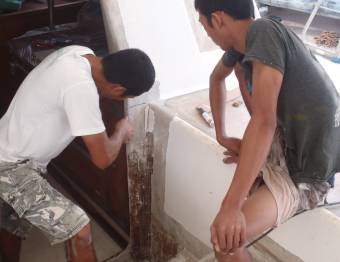
Golf & Max check the extent of bad balsa at the entryway
21 Cockpit Surgery
 Golf & Max check the extent of bad balsa at the entryway |
Summary: This was a week of investigative surgery to remove damaged wood. Much of Ocelot's entryway wood was removed, as well as a strip of the salon floor under the navigation station and the entire helm area. But most of the floorboards got all of their coats of varnish, and Golf's happy with the quality of the work. Workers started long‑boarding the hulls in preparation for spraying them. The bows got reinforced with fiberglass and epoxy mud, and an area to the right of the entryway was re‑glassed. Two of our big cockpit hatch‑covers were stiffened wonderfully with foam and fiberglass and the other 4 are being worked on. Work has started on stripping our fore‑beam and other aluminum fore‑deck bits in preparation for painting them, and Jon drilled out almost 100 cores around existing bolt holes in our cabin top so they can be filled with epoxy mud, re‑glassed, and the holes re‑drilled.
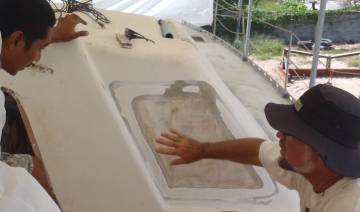 Golf & Jon discuss how best to repair this area |
Monday, March 12:
A bit more investigative surgery today, but we think we've found the end of it.
Hope so, at least. Handsome Max cut away the outer layer of fiberglass around the bottom part of our entryway until
he got to the limit of where the wood was bad. This was a bit higher than we'd originally
thought, but it should be no problem to repair. Golf wants to investigate a bit more under
where our sliding entryway door is, just to make sure he's found all the issues. The support
under the door needs to be rebuilt anyway, as it was uncoated plywood which has long since rotted
away. But that should be fairly easy and we're already discussing how best to repair the areas
that have been opened up.
The area to the right of the entryway had the surrounding fiberglass faired back in a shallow scarf, so we can lay several sheets of fiberglass over the area and then fair in the edges so it won't show. We'll paint the balsa in epoxy first, as the blocks of balsa don't appear to be held together on their sides, just where they're bonded to the inside skin of fiberglass.
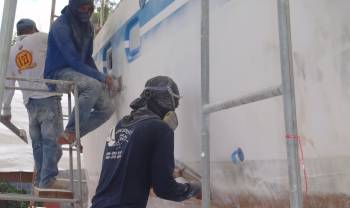 Workers long-boarding Ocelot's port hull |
We also had several guys working on the port hull, sanding it flat with long‑boards. These are also sometimes known as "torture‑boards" as the work can be very tiring and it all has to be done by hand. They're currently using 80‑grit sandpaper, but they'll use ever finer grades until Ocelot's hull is mirror smooth. This sounds easy but it's not. They've been working on our neighbor, Rackam, for several weeks and they're only just getting ready for the final coats.
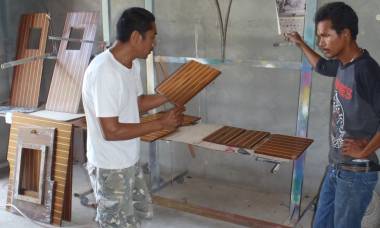 Golf & Baw examine one of the floorboards in the workshop |
In the woodshop, Houa has finished a nice fiddle‑rail for the edge of the storage area between the stove and the sink. Now he's taken away the door to our rubbish locker. He'll cut it down and then use the top part as the front of another (cutlery?) drawer for us. Our old cutlery drawer was between the stove and the oven, and it was lost when we put in a new stove/oven combo unit. The drawer Houa put under the oven is wonderful and actually bigger than our previous cutlery drawer, but it's a bit difficult to get to. This new drawer won't be very big, but it will be much easier to get to. History will determine what the drawers get used for.
When we talked to Houa about how he was going to do the work, we found that he's planning to use our existing piece of teak. He'll cut the drawer‑front and the separator strip from that piece of wood, so the grain all matches vertically. Ya' gotta love that kind of cabinetry‑work!
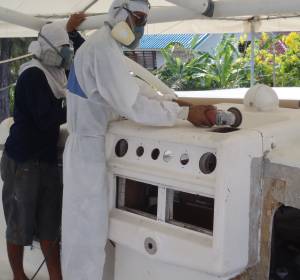 Max cutting off Ocelot's instrument console |
Tuesday, March 13:
This morning we started out by visiting Golf's workshop, about 3 miles (5 km) from the boatyard.
There the 2 varnishers were working on all the bits of teak that we've removed from Ocelot.
They're all being sanded, inspected, and repaired if necessary. Then they're putting on
4 layers of 2‑part polyurethane varnish, and another 3 layers of regular varnish. Since
they're not with the other guys at the boatyard, we gave them a big bottle of cola to drink.
We usually give the guys at the boatyard a big bottle every day, sometimes 2 if it's a hot day
or if they're doing dusty work.
We'd hoped that we were near the end of the exploratory surgery stage but we're not quite there yet. Max had to do more exploratory surgery on Ocelot, tracking down abused balsa. Max opened up more suspect areas around the entryway but didn't find too much. The area under our entryway door needs work, but we knew that already. He cut some of that area away so it can be rebuilt correctly, and he'll do a bit more tomorrow as well.
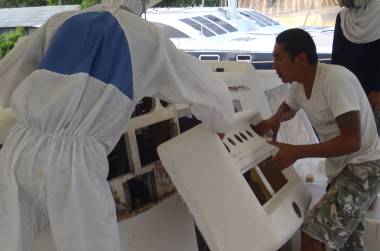 Max & Golf lifting away Ocelot's instrument console |
But our investigations led us to more soft wood around the helm. Ocelot has an unusual helm area, in that a fiberglass cover was put over the original helm area, and this is what our instruments and engine controls are mounted on. The cover has a wider area for mounting instruments, so we can have an autopilot control, 3 sailing instruments, and 2 fuel gauges mounted. But the original helm station, with the original cutouts for instruments etc, is still visible under the newer cover (in fact, this original is a pain in the patootie when we're trying to do something with our instruments, as it's often in the way). Not only was there soft (and exposed!) balsa in the fiberglass sandwich holding the steering gear, but the new cover was never correctly attached to the helm area. It was simply plonked on top and a bit of gelcoat was splashed around the edges. Gelcoat is brittle and has no strength, so we've always had cracks around the edges of this cover.
So Jon moved the engine instruments off to one side and removed the steering gear, and Max cut most of the new cover off so he can start digging out the soft balsa tomorrow. The tricky part here is that the steering gear has to go back exactly where it was. So Golf asked our carpenter to make a board for the steering gear to mount to, when we put it all back together. This should be stronger and more durable than just foam inside the fiberglass.
 Jon, covered in sweat, drilling cores under the port sail-track |
Golf has promised us repeatedly that he can put everything back that he's taken apart. Sure hope he's right, because we certainly can't...
Jon continued his campaign to drill out all the places where deck hardware (winches, sail‑tracks, turning blocks, rope clutches, etc) bolt through the cabin‑top. We want to drill out the inside layer of fiberglass and the coring around those holes, then replace the coring with epoxy‑mud, and replace the inside fiberglass with new glass. When the epoxy is hard, we'll re‑drill the holes so we can re‑mount the deck hardware, but the new holes will be going through much more durable epoxy‑mud instead of the foam core. Of the roughly 100 bolt‑holes to be drilled out, Jon's now done a bit more than half. Not only is it a tiring job (the fiberglass layer inside is thick and there's no air circulation with the boat all closed up) but the low voltage at the boatyard makes his drill‑motor heat up, so we have to let it rest or we'll destroy it.
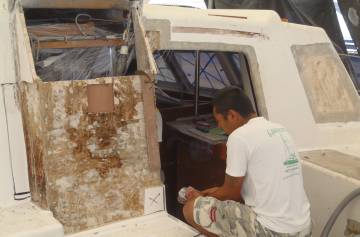 YIKES! What's happened to Ocelot's helm station?!? |
Houa was working quietly on another drawer for us, to go above our rubbish bin. It's so nice to have someone on the team who doesn't need much guidance. You give Houa a job and he goes away and does it, with no fuss or bother, and only enough questions to insure he knows what you want.
Wednesday, March 14:
A strangely depressing day for us, and we're not sure why - maybe because it was all destruction
with no construction at all. This morning the guys removed all the soft balsa from the area
under the helm. They also cut away the upper part of the old, interior helm that was just in
the way.
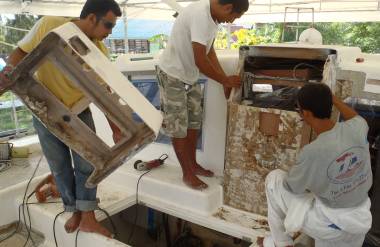 Discussing how to repair the helm with Boy, Golf, & Max |
We talked extensively to Golf about how to restore the helm area. The problem is that the fiberglass that's left, the interior wall of the old helm area, is very thin and flimsy. If it was left to us, we'd reinforce the existing flimsy fiberglass with plywood until we got some foam bonded to it, and build up from there. Golf doesn't think the helm area glass is worth saving. He wants to rip it all out, rebuild it (on a mold?) and then epoxy the new helm area back on where the old one was. This is certainly not the way we would do it, but Golf has many talents we don't. We're not sure that Golf can get the steering gear to line up exactly, but we learned long ago to let craftsmen do their job their own way. Even if it takes longer, they take pride in their work and you get a better job in the end.
Elsewhere, Houa continues to work on a drawer for us. He seems to be making it out of plexiglass(!) which he'll cover in formica before putting on the teak front. In the workshop, the varnishers apparently sprayed at least one coat of varnish on our floorboards. While polyurethane varnish dries very quickly and can be sanded in less than an hour, they're now using normal Epiphanes varnish which usually takes 8‑10 hours to dry before it can be sanded again, so work goes a bit slower.
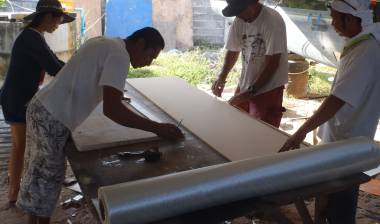 Mia, Golf, Jon & Boy all working on the hatch covers |
Thursday, March 15:
Some steps forward, but also some steps sideways today. Golf has decided (for now) to repair
our helm station in situ, instead of ripping it out and starting over from scratch. The trick
will be stiffening the existing flimsy fiberglass so we can stick some foam onto it. Once the
foam is on, it should be stiff enough for us to reinforce it where necessary.
Max, in his relentless efforts to reduce Ocelot to a pile of dust, found a bit of wet plywood under our salon floor by the nav‑station, and some soft balsa in a rather inaccessible spot behind the galley. Neither one seems very critical right now, but both need to be investigated. The wet plywood is explainable and should be easy to repair and seal back up again. We just have to make sure that no more water gets into that area.
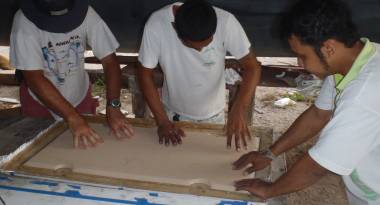 Jon, Golf and Boy laying the foam for a hatch cover |
The catamaran Hard Yakka, behind us, had siphoned off some of Golf's workers, but now that Todd, who's been overseeing the work, has left for a 10 day visa run to Langkawi, we suddenly have more workers on Ocelot. Most of these were put to work long‑boarding our topsides, so that work is progressing. Getting the hulls in shape to be painted is a HUGE job that will take a long time. The workers on Rackham, the racy French cat next to us, have been prepping her for about 2 months, and won't get to spraying the final coats until next week sometime. With painting, the vast majority of the work is in the preparation.
At our request, Golf has started reinforcing our 4 big cockpit hatch‑covers. When we ripped the teak off these, we found that they were then too flimsy to walk on. SunSail had done a quick and slapdash repair on one of them, but it was still too flimsy to walk on without the teak on top. Since the new cockpit teak will only be glued down (not screwed) we need to make sure the hatch covers are fairly stiff by themselves, and don't rely on the teak. To this end, we want to epoxy a sheet of ½" (12mm) foam and a couple layers of biaxial glass onto the undersides of the hatch‑covers. We need some of these hatch covers in the cockpit so we can walk around, so we'll reinforce 2 of them and then put them in the cockpit while we work on the other 2.
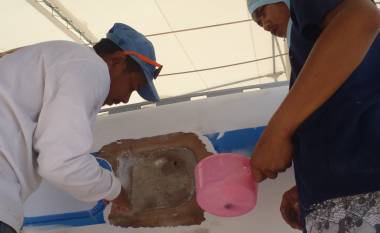 Goy & a helper filling a badly repaired misplaced porthole |
So today Boy ground all the gelcoat and SunSail's slapdash repair off the bottom of 2 of the hatch‑covers. We cut and shaped the foam and late this afternoon we stuck the foam down. The hatch‑cover that goes under the helm‑seat was relatively thick so it didn't need any additional fiberglass, but the other hatch‑cover was so thin that Golf insisted on putting a layer of biaxial glass under the foam. We left them weighted down with 3 big water jugs each at 6:45pm when we left the yard. In the morning we'll prep them and lay a couple of sheets of biaxial glass over the foam.
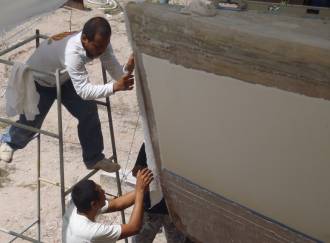 Goy & Golf reinforcing Ocelot's bows with biaxial glass |
Friday, March 16:
A pretty good day, all things considered. When we got to the yard we found 2 men already hard
at work long‑boarding the port hull. On starboard hull, Goy was beginning to fill and epoxy the
hole left by a poorly repaired misplaced porthole years ago. When he finished that, he filled the joint‑line
down both our bows with epoxy mud and then laid 2 strips of fiberglass down the seam‑lines.
This should reinforce our bows a bit, and make them ready for Golf to do his magic to make our bows
a bit more pointed. We don't want them sharp, but it will be nice to have them a bit more
water‑cleaving.
Golf and Jon came up with a good quick fix for the inaccessible soft balsa we found yesterday. The balsa has been wet but is now quite dry, so we'll pour epoxy in at the top until it comes out the bottom. This will allow the epoxy to saturate the balsa, making it waterproof for the future and also reestablishing the structural integrity of that wall. Then we'll cap the wall properly, sealing it with epoxy mud and fiberglass so no more water can get in. We're amazed that Wauquiez left that balsa open for water to get in.
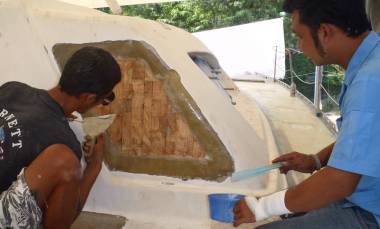 Max & Boy fiberglassing the bare balsa in the cockpit |
On the down side, Max and his chisel found that the wet plywood near the entryway extended farther forward than we had thought. Replacing it will be a big job, and Golf is concerned that we find all the damaged wood and get it out. Stay tuned on this one.
In the afternoon the guys did several more fiberglass jobs: Max finally glassed over the section of raw balsa to the right of the cockpit. The balsa here was fine, but the outer layer of glass had never adhered to the balsa, creating a small void that we'd opened up for examination. We'd worried it might suck in moisture from this humid Thai weather, so it's nice to have it sealed up again!
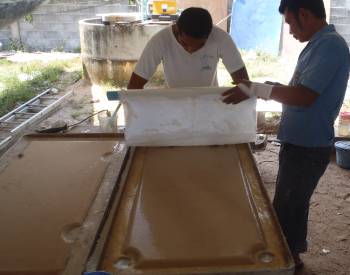 Golf & Boy glassing the newly foamed hatch covers |
The guys also glassed over the 2 cockpit hatches that we'd foamed yesterday. They look very spiffy now, and will certainly be a lot stronger. Once Golf smoothes them with some fairing compound and replaces the rubber gasket around the edge, we'll put them back in service so we won't have to dance so much, avoiding open cockpit lockers as we move around the cockpit.
We were happy to see that one guy was set to grinding the paint off one of our aluminum bow fittings: the big bracket that holds the anchor chain platform. There are so many of these seemingly small jobs to get done, it's nice to see them being worked on. Jon added to the noise (and progress) by drilling out the last of the 100(!) bolt holes that are on our cabin top for all the sail track and winch fittings. Next job there will be to pull the plugs out and then fill them with epoxy mud and fiberglass so he can re‑drill the holes from the top.
We got good news from the workshop that Baw and Ben have finished the varnish on all the floorboards, which are now wrapped in paper in the workshop awaiting the day when they can be put back.
 Grinding the paint off a bow fitting to repaint it |
Our scooter‑drinks lady is coming consistently at 3pm to give us our fresh squeezed lime and soda water fix. Every few days we buy a round for all the workers, but with 10 of them now it gets a bit pricey! Sort of like a whole dinner out. But it's worth it, and we're happy to have the guys take a "drinks" break in the heat of the afternoon.
We look forward to more cruising friends joining us in the yard in the next couple weeks. Already Susannah and Richard from Ultimate Dream are out of the water and will be extending their transoms, much as we plan to do. Graeme and Lorraine on Katani 2 (who were on our 2006 Indonesian Rally) will be hauling out in early April. We foresee a big birthday party for Jon on the 7th with lots of friends!
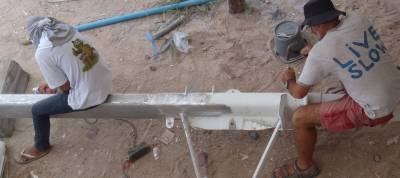 Working on our big fore-beam, getting it ready for repainting |
Saturday, March 17: A good day...
By the time we got to the boatyard the day was in full swing. Boy was grinding the old gelcoat
off more of our cockpit hatch‑covers. We decided that the engine hatches are already strong
enough so that means Boy only has 6 hatch‑covers to do. Two of them are smaller and should go
relatively quickly but 3 of the big ones had insufficient reinforcing underneath which now needs to
be ground off. He's now finished 3 of the 4 big hatch‑covers. He'll be glad to finish,
as it took him all day to do just one hatch‑cover.
Under Ocelot's bow one of the workers was grinding the paint off Ocelot's big fore‑beam, getting it ready to paint. Jon realized that there were still some bits that needed to be removed, but they were all held on with stainless steel bolts into the aluminum beam. So he dug out his impact screwdriver and spent a few hours whacking at the corroded bolts to get them out.
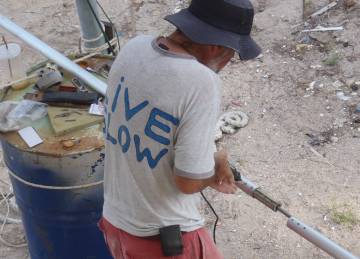 Jon working to get our roller gear apart to install new wire |
Three guys are still long‑boarding the outer hulls. They spray on a bit of black paint and then sand away until all of the black paint is gone. It takes them pretty much a full day to do just one side. So far, nobody is working below the waterline or on the insides of the hulls or under the bridge‑deck, but we're sure that will be coming...
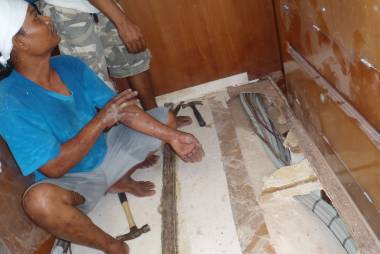 Houa, after ripping up Ocelot's salon sub-floor |
Jon's propane blowtorch has run out of gas, and Thailand appears to use a different system so he can't replace his bottle. So today Golf paid $50 for the Thai equivalent. Jon has been waiting for that torch for several days, as the last grub‑screw in our roller‑gear was stuck. It only took 30 seconds of heat and it came out very happily. A bit more dremmel work and he was able to get the roller‑gear sections apart.
But we're still not sure what wire to use for our headstay. It's currently ½" (12.7mm) Dyform, which isn't made anymore. The local riggers seem to think that 12mm Dyform would be OK, but that's an 11% reduction in strength from what we have. 14mm Dyform is available, but it would take a lot of work to make it fit inside our roller‑gear (which was only designed for ½"). The path of least resistance is to go with the 12mm, but we don't like the thought of going down in strength...
Inside Ocelot, Golf, Max, and now Houa were tracking down wet wood and old bug‑tracks. Houa was called in to use his carbide‑tipped skill saw to carve up the floor of the salon, just in from the entryway. It's faster and produces much less fiberglass dust than a cutting wheel on a grinder. This part of Ocelot is fiberglass wrapped plywood - a very strong method of construction but organic, so prone to problems if water or bugs get in. Apparently both have been into this particular bit, but they couldn't get any further. After removing that strip of wood, the guys all proclaimed it done.
What this means is, we think we're finally at the end of the exploratory surgery stage. WOOT! We're sure we'll find other areas that will need work as we continue our renovations, but they shouldn't be very big. It will be VERY nice to move into the reconstruction phase, putting Ocelot back together again, but better this time!
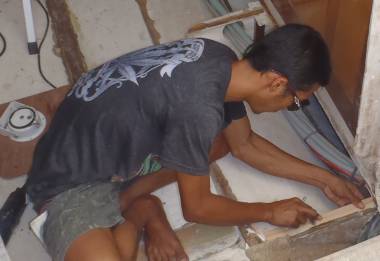 Max shaping & fitting new foam supports for the salon floor |
We talked to Golf about how he'd put everything back on the floor. He asked if we needed it done in
plywood, like it was, and we replied not necessarily, wanting to hear his ideas. Golf
suggested that we put more supports under this bit of flooring, but then do it in foam and biaxial
glass. Sounds good to us. This should make it just as strong but probably lighter than
the original. Certainly the inorganic‑ness of it appeals to
us. ![]()
 Jon removing screws from our forward hatches |
Sunday, March 18:
The guys don't usually work on Sundays, but having said that, we notice that they've worked the last
3 Sundays, including today. Apparently they get paid a normal day's wages ($25‑40) but they
only work from 9‑3 or so.
We got to the yard mid-afternoon and only Houa, Max, and Boy were still there. Boy was grinding gelcoat off the bottoms of our hatch‑covers. Max was shaving down foam supports for the floor, shaping them to match the curve of Ocelot's hull where they took the floor out. The original floor only had 3 supports, and they were irregularly spaced, but the new floor will have 6 molded in supports, evenly spaced.
Houa was trying to remove our hatches at the front of the salon and running into the classic corrosion problems of stainless steel screws into aluminum. He was all for drilling the screws out, but we knew that would probably destroy the (expensive) hatch so Jon dug out his impact screwdriver and started tapping the screws out.
Thai Refit:
Ocelot Pages:
Top Level: Home | Destinations | Cruising Info | Underwater | Boat Guests | Ocelot | Sue | Jon | Amanda | Chris | Site Map | Make a Comment
|
If our information is useful, you can help by making a donation |
Copyright © 2000‑ Contact: Jon and Sue Hacking -- HackingFamily.com, svOcelot.com. All rights reserved.